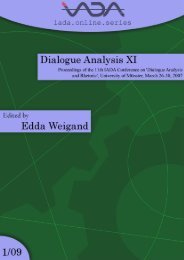Dialogue in and between Different Cultures - International ...
Dialogue in and between Different Cultures - International ...
Dialogue in and between Different Cultures - International ...
Create successful ePaper yourself
Turn your PDF publications into a flip-book with our unique Google optimized e-Paper software.
Contrastive Analysis of English <strong>and</strong> Polish Military Texts 91<br />
written for chief logisticians <strong>in</strong> a brigade or division, <strong>and</strong> the NATO logistic<br />
publication, Sample 5, is designed as an <strong>in</strong>troductory book for anybody who is<br />
<strong>in</strong>terested <strong>in</strong> logistic concepts. Only when it comes to logistics <strong>in</strong>telligence, the<br />
English text is more <strong>in</strong>clusive. As a rule, the NATO samples (2, 4, 5) can be<br />
labeled as comprehensive <strong>and</strong> their Polish counterparts as detail-oriented.<br />
4. Topicaliz<strong>in</strong>g<br />
The language of regulations, st<strong>and</strong>ardiz<strong>in</strong>g acts <strong>and</strong> comm<strong>and</strong>s should be simple,<br />
which does not mean poor or primitive. In fact, it should be a quick but effective<br />
<strong>and</strong> economical means of convey<strong>in</strong>g mean<strong>in</strong>g. The communicative character of<br />
the military vernacular is <strong>in</strong>creased by the established <strong>and</strong> uniform formulas of<br />
expression, e.g. orders, regulations, or reports. Generally, utterances orig<strong>in</strong>at<strong>in</strong>g<br />
from the military milieu should be communicative, i.e. they should show the<br />
ability to reach the reader or listener’s consciousness. As far as the military<br />
communication is concerned, a piece of discourse can be labelled as communicative<br />
if it is concise. Conciseness is characteristic of those texts which succeed <strong>in</strong><br />
be<strong>in</strong>g communicative <strong>and</strong> short at the same time. In other words, conciseness<br />
consists <strong>in</strong> construct<strong>in</strong>g expressions so that they are short but <strong>in</strong>formative at the<br />
same time. Military authors’ desire to be concise is visible <strong>in</strong> their use of<br />
abbreviated forms, comm<strong>and</strong>s, <strong>and</strong> cryptonyms.<br />
The logistic documents under <strong>in</strong>vestigation adhere to the pr<strong>in</strong>ciple of<br />
conciseness <strong>in</strong> many ways. First of all, they build sentences that feature a lucid<br />
syntax <strong>and</strong> unref<strong>in</strong>ed vocabulary. The texts do not overuse rare expressions or<br />
words, especially of a foreign orig<strong>in</strong>. Second, logistic texts feature a clear manner<br />
of thought transmission. They select words to convey ideas clearly. The<br />
<strong>in</strong>vestigated NATO documents also give precedence to sharply def<strong>in</strong>ed terms.<br />
Third, the description of organizations, procedures, <strong>and</strong> tasks is exact. Military<br />
writers also pay much attention to the legibility of their written documents. The<br />
tone of the military documents is categorical, i.e. they do not allow for any<br />
discussion or refusal. Additionally, texts of the military<br />
− are objective <strong>and</strong> precise, with visual-verbal relation as their supportive<br />
element;<br />
− avoid metaphor;<br />
− support their claims with empirical evidence from nature.<br />
What is more, military writers do not need to resort to persuasive means of<br />
communication. In most cases, their writ<strong>in</strong>g is supported by the authority of a<br />
military committee the work of which is presented <strong>in</strong> a document. For example, <strong>in</strong><br />
the case of STANAGs the procedures that they <strong>in</strong>troduce result from a broad<br />
discussion among the representatives of all Allied nations. More importantly,<br />
however, each NATO document is signed by an authorized person. The signature<br />
signifies enforc<strong>in</strong>g the st<strong>and</strong>ard which the document presents. Obviously, military



